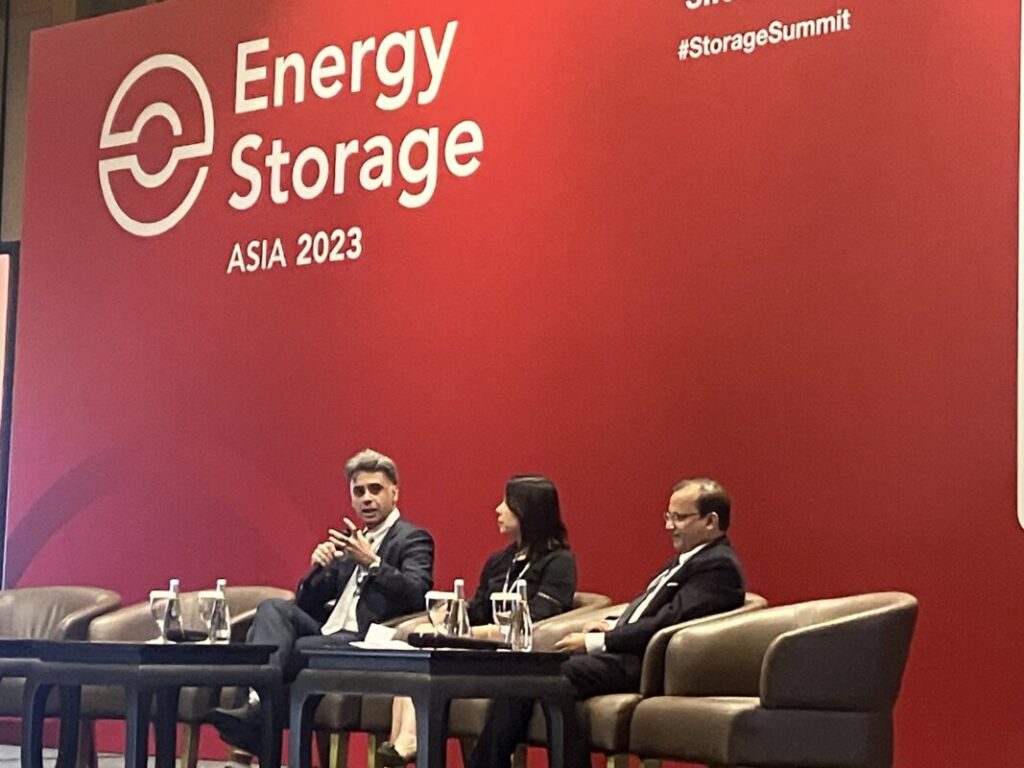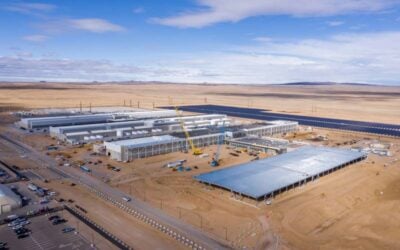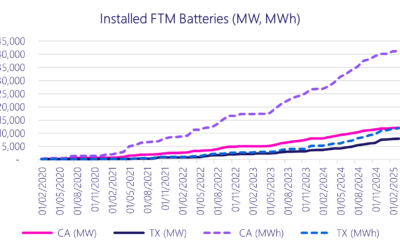
Scaling up net zero-enabling battery storage technologies will require financiers and investors to share risks with developers, such as those over supply chain.
That was the view of Mahdi Behrangrad, head of energy storage at Japanese renewable energy developer Pacifico Energy, speaking at Energy Storage Summit Asia 2023, hosted in Singapore last week by our publisher Solar Media.
Enjoy 12 months of exclusive analysis
- Regular insight and analysis of the industry’s biggest developments
- In-depth interviews with the industry’s leading figures
- Annual digital subscription to the PV Tech Power journal
- Discounts on Solar Media’s portfolio of events, in-person and virtual
Pacifico Energy is considered Japan’s biggest developer of solar PV power plants, and recently became the first company in that country to trade energy with battery energy storage system (BESS) projects.
In a panel discussion on how to effectively manage energy storage supply chains, Behrangrad said that energy storage has become “a victim of its own success,” in that an industry race to secure materials and equipment is now on.
That’s particularly the case when electric vehicles (EVs) are currently accounting for 80% to 90% of battery cell procurements from a pool shared largely with the stationary storage industry, fellow panelist Le Xu, commercial manager for power markets and new business at investor-developer Aquila Clean Energy Asia-Pacific (ACE APAC), said.
While demand for lithium batteries from the EV sector originally drove costs down and supply chain scale up, that sort of competitive dynamic in which battery storage is currently a distant second, is something the solar and wind industries never faced.
With batteries accounting for perhaps 40% to 50% of BESS equipment costs, the squeeze on supply of raw materials to make them is felt much more acutely than in making solar modules, Xe said.
Meanwhile, session chair Shuvendu Bose, senior advisor to the UAE Ministry of Energy said, investing in the raw materials value chain carries a technology risk in itself.
Bose cited the example of lithium iron phosphate (LFP) overtaking nickel manganese cobalt (NMC) as the battery cell chemistry of choice in the BESS sector, and latterly also for shorter range EVs. If investing in a raw materials extraction or refining facility, Bose said, there is often limited visibility beyond perhaps 5-6 years on how much demand there could be for materials that might be replaced by better options.
It isn’t just batteries or raw materials that carry supply chain risk. Pacifico Energy’s Mahdi Behrangrad said that during the last couple of years, during the COVID-19 pandemic’s global slowdown which impacted logistics, getting other equipment like transformers, or even “small things” like sensors, became challenging and a wait.
‘Melting ice’
That’s another particular problem that battery storage has which other clean energy technologies don’t face, at least not as acutely, according to the developer. Likening it to “melting ice,” Behrangrad said that once a battery leaves the factory, degradation begins. The clock starts ticking and a project has a finite amount of time left to make money, and any delays on that can be costly.
Even if a project’s expected lifetime in the field is as long as 20 years, a logistics delay of several months will impact the business case, Bose concurred.
“If we want this thing, this dream (of net zero) to happen, everybody needs to do their homework,” Behrangrad suggested.
“The financiers and investors at the top… I do understand that by default this outsourcing [of] the risk, and de-risking their own business and passing on the risk is the custom, but they should be ready to understand that there will be risks involved with this volatile world.”
One such example Behrangrad gave is that it should not only be developers being confronted with the risks associated with fluctuating materials or equipment prices.
As the industry and regular readers of Energy-Storage.news will likely be aware for example, many energy storage companies have moved towards Raw Material Indexed (RMI) pricing for contracts. Facing with moving targets to aim for, many system integrators have found that they need to share the risk of fluctuating prices with customers.
Achieving net zero ‘vision’ requires risk appetite
That said, developers themselves have “homework” to do in mitigating their own exposure to risk, Behrangrad said.
Pacifico Energy has enough in-house “technical capability” to do due diligence that it can comfortably shop around for suppliers, he claimed, extending its reach beyond Tier-1 battery makers into Tier-2.
“If one entity cannot handle this raw material thing, good: we go to another option. We [the industry] should increase our options, which means we do our work understanding the technology.”
“If we believe in this vision, and we want this thing to happen, we can’t look at it as a sense of saying this is a typical investment. Everybody should do their part, regulators, manufacturers, investors.”
Aquila Capital is an asset manager focused on sustainable infrastructure. Worldwide it has a 14GW portfolio of solar, wind, hydroelectric and battery assets invested in on behalf of institutional investors.
ACE APAC is a newer entity, with about 1GW of assets across the different technologies in the Asia-Pacific region since 2020.
Commercial manager Le Xu agreed with Behrangrad’s message from an investor standpoint, adding that supply chain risks are wrapped into the whole spectrum of risks in a project’s lifecycle.
With raw materials costs rising “dramatically” in recent times, as of 2021, the cost of a 100MW BESS project would be equivalent to the cost of a solar PV plant double that size, or a wind project of roughly 130MW to 140MW.
That and the well-publicised difficulty of modelling long-term revenue projections for battery storage mean that it is “not easy to take the risk and to invest”. But ACES APAC in 2022 committed to the acquisition of a 220MW/440MWh pipeline of BESS projects in development in Australia. The company’s technical understanding and belief in the fundamental value of the assets in Australia’s merchant markets made the transaction a risk it was willing to take, Xe said.
Read more coverage from and related to Energy Storage Summit Asia 2023 here.
Read Hendrik Bohne from Aquila Clean Energy Asia-Pacific’s Guest Blog for this site, ‘How battery storage accelerates decarbonisation in Asia-Pacific’ here.
Energy-Storage.news Premium subscribers can read our interview with Pacifico Energy’s Mahdi Behrangrad, ‘Industry Insights: Putting BESS into Japan’s power trading markets with Pacifico Energy’ here.






